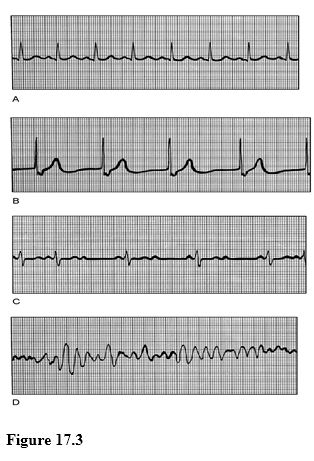Using Figure 17.3, match the following:

1) Ventricular fibrillation.
2) Second-degree heart block.
3) Junctional rhythm.
4) Normal sinus rhythm.
1) D
2) C
3) B
4) A
You might also like to view...
Second-class levers are the most common in the human body.
Answer the following statement true (T) or false (F)
Whales and seals prepare for a dive by
A) Storing excess blood in the liver for later use. B) Sequestering high levels of intracellular calcium to buffer pH changes. C) Saturating myoglobin stores with oxygen. D) All of the above
Choose the correct statement regarding the atrial reflex
A) It involves triggering a reflexive decrease in the heart rate through increased parasympathetic activity. B) It involves stimulating pain receptors in the right atrial walls as blood enters the right atrium. C) It involves adjustments in the heart rate in response to an increase in the venous return. D) It involves sympathetic stimulation, which results in increased heart rate. E) It involves parasympathetic stimulation, which increases the heart rate.
Which of the following is NOT a cranial nerve that innervates the extrinsic eye muscles?
A. Oculomotor B. Trochlear C. Abducens D. Trigeminal